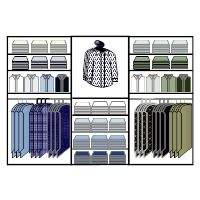

Because the planogram allows you to keep well-organized shelves, aisles, and sections, it becomes easier for employees to see when an item needs to be restocked.Īdditionally, retail planograms allow you to organize where products go and determine how much of a certain product can be displayed at once. To maximize your selling space, you can also use a retail planogram to help manage product inventory and inventory space. And, if you still don’t see the results you want, you can then determine what did and didn’t work in terms of utilizing and optimizing the available space. You can also experiment with different retail planograms and layouts until something sticks and then test it with real shoppers. You can shuffle products around, change up how products are displayed, or completely overhaul the floorplan to make the most of the square footage. That’s why retailers use planograms to assign selling potential to various areas throughout the store.

To offset this financial impact and become a cost-effective operation, it’s important to utilize every inch wisely.

Whether you’re buying or leasing a retail space, it’s going to cost a lot of money. The types, number, and level of detail merchandisers can use in creating planograms is practically endless.īelow, we’ll dive deeper into the overall benefits of using a planogram (or set of planograms) for both large and small retailers. A small clothing store could even have a floor-layout planogram and one general planogram for each type of display. They could also use them to organize specific aisles by product type and size (like drill bits). Smaller retailers (like a mom-and-pop hardware store) could use a planogram to create simpler floor-layouts to better organize key sections and products. For larger stores, they help organize areas with heavy foot traffic and categorize stores with a multitude of products - including stores with multiple locations. Planograms are incredibly useful to both small and large stores alike. Reduce congestion of shoppers in areas with a lot of foot traffic.Īdditionally, you can use them to experiment with displays and improve customer satisfaction by amping up the store’s aesthetics.Understand how much of each product should be displayed.Assist with staff’s restocking efforts.Have a clear map of where everything in the store is located.Identify and assign selling potential for different areas of a store.Place certain products in ideal locations, such as near a specific part of the store or at eye level for shoppers to easily spot.Other reasons to use a planogram, include: Planograms serve to guide shoppers through the store and toward necessary or high-selling products.īut they can also map out ways to lead customers through new product displays or pathways that lead up to checkout. The main purpose of a retail planogram is to organize goods around the store logically and efficiently. What is the purpose of retail planograms? Some even include the exact measurements of a section to ensure products will fit accordingly. This could include shapes that resemble the products they offer, such as food items or clothing. These diagrams could be a simple map of the store floor with boxes labeled for each section or aisle.Īlternatively, they could also use a color-coded system to showcase which aisles are assigned to each section of the store.
#Retail store planogram software
However, the complexity and detail of a planogram depend on a store’s size, product offerings, and software (or tools) they used to create the planogram. It’s this level of detail that allows nearly any type of retailer to find the absolute best placement for their products. In addition to planograms that map out a whole store floor, a retailer may include sub-planograms for every: You may also see planograms used as flow charts to track how shoppers typically navigate through the store and proceed to point of sale. Think of it like a schematic that documents in what aisle and on what shelf you can find a specific product. What is a planogram?Ī planogram is an important visual merchandising tool that presents the layout of products throughout a brick-and-mortar store - on shelves and in displays.


 0 kommentar(er)
0 kommentar(er)
